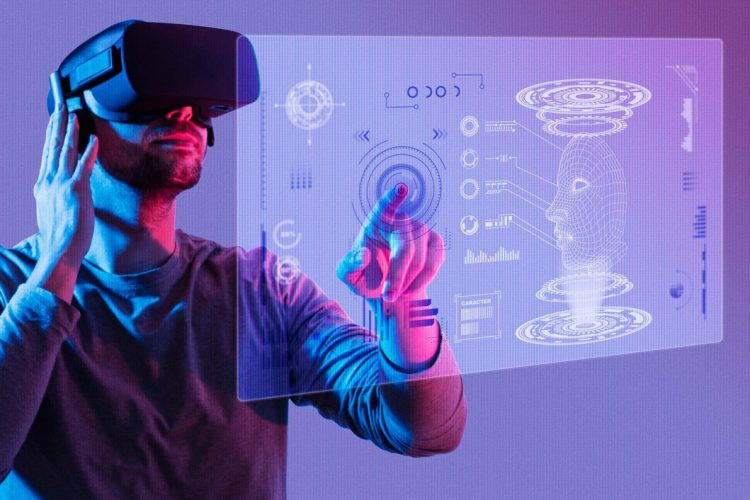Introduction
Virtual Reality (VR) has evolved from a niche entertainment tool into a transformative technology reshaping how people learn, heal, and interact. As immersive headsets, haptic devices, and advanced software become more accessible, VR is no longer confined to gaming or simulation.
Today, VR stands at the forefront of a new digital revolution—one that blurs the boundaries between physical and virtual worlds. This article explores how VR transforms education and healthcare while reimagining the very nature of human experience in the 21st century.
1. The Evolution and Key Features of VR Technology
1.1 Early Roots of VR
The idea of immersing users in a virtual environment dates back to the 1960s with early prototypes like the “Sensorama” and head-mounted displays. However, hardware limitations and high costs confined VR to research labs for decades.
1.2 Breakthroughs in the 21st Century
The 2010s marked a turning point as consumer-grade devices such as the Oculus Rift and HTC Vive entered the market, offering affordable and high-quality immersive experiences.
1.3 Core Features Driving Adoption
- Immersive Visual and Auditory Input: High-resolution displays and spatial audio create realistic virtual environments.
- Interactivity: Motion-tracking sensors and handheld controllers allow natural movement and manipulation.
- Presence: VR’s ability to create a sense of “being there” differentiates it from other media technologies.
2. Transforming Education with VR
2.1 Immersive Learning Environments
VR classrooms allow students to explore historical events, walk through molecular structures, or engage in complex problem-solving in safe, simulated spaces.
2.2 Enhancing Engagement and Retention
Studies show that immersive learning improves knowledge retention by providing experiential rather than passive learning opportunities.
2.3 Bridging Gaps in Accessibility
VR makes world-class education more accessible by reducing the need for physical resources—students in remote regions can participate in virtual science labs or cultural exchanges.
2.4 Case Studies
- Labster: Offers virtual science labs for universities worldwide.
- Google Expeditions: Enables students to take virtual field trips to historical sites and natural wonders.
- VictoryXR: Builds fully immersive classrooms, often in partnership with VR headset manufacturers.
3. VR’s Impact on Healthcare
3.1 Medical Training and Simulation
VR allows medical students and surgeons to practice complex procedures in a risk-free environment, improving skills and reducing errors.
3.2 Pain Management and Therapy
Immersive VR experiences have been shown to reduce pain perception and anxiety in patients undergoing treatments such as burn therapy or chemotherapy.
3.3 Mental Health Applications
VR-based exposure therapy helps individuals confront phobias, treat PTSD, and practice mindfulness in controlled, immersive settings.
3.4 Remote Healthcare Delivery
VR supports telemedicine by enabling virtual consultations and interactive physical therapy sessions, particularly valuable in underserved or rural areas.
3.5 Case Studies
- Osso VR: A surgical training platform that has significantly improved procedural efficiency.
- AppliedVR: Provides VR-based pain management therapies for hospitals and home care.
- Oxford VR: Focuses on mental health treatment through immersive therapy sessions.
4. Reimagining Human Experience and Social Interaction

4.1 Virtual Collaboration and Workspaces
VR platforms like Horizon Workrooms and Spatial create immersive meeting spaces, offering a sense of presence that video conferencing cannot replicate.
4.2 Cultural and Entertainment Experiences
From virtual museum tours to live concerts in VR worlds, the technology opens new avenues for cultural exchange and artistic expression.
4.3 Social Inclusion
VR can empower individuals with disabilities by providing access to environments and experiences otherwise inaccessible in the physical world.
4.4 Risks and Challenges
Prolonged immersion raises concerns about psychological well-being, potential social isolation, and the blending of virtual and physical realities.
5. Challenges and Ethical Considerations
5.1 Accessibility and Affordability
High hardware costs and the need for reliable internet connectivity still limit VR adoption in many regions.
5.2 Data Privacy and Security
Immersive environments collect vast amounts of biometric and behavioral data, raising critical concerns about surveillance and misuse.
5.3 Ethical Design of Experiences
Developers must ensure that VR content avoids manipulation, bias, or harmful simulations that can negatively affect users.
5.4 Physical and Cognitive Health
Managing motion sickness, eye strain, and the psychological impacts of extended VR use is crucial to fostering responsible integration.
6. Future Outlook
- Integration with AI:
AI-driven virtual tutors and adaptive simulations will personalize education and healthcare interventions. - Advancements in Haptic Technology:
Tactile feedback devices will further blur the lines between the virtual and physical worlds. - Expanded Accessibility:
Affordable, lightweight VR headsets and cloud-based delivery models will democratize access. - Global Collaboration:
VR will play a central role in enabling real-time, immersive collaboration across borders in education, healthcare, and creative industries.
Conclusion
Virtual Reality has progressed far beyond its origins as a novel entertainment tool. It is transforming classrooms into immersive learning hubs, revolutionizing healthcare delivery, and offering new ways for humans to connect and grow.
As society embraces VR, the focus must remain on equitable access, ethical practices, and responsible innovation to ensure that this powerful technology enhances—not diminishes—human well-being.
















































